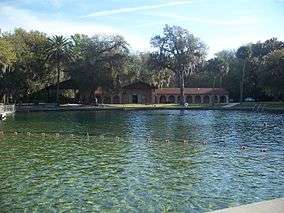De Leon Springs State Park
| De Leon Springs State Park | |
|---|---|
|
IUCN category V (protected landscape/seascape) | |
 | |
 | |
| Location | Volusia County, Florida, USA |
| Nearest city | DeLeon Springs, Florida |
| Coordinates | 29°08′24″N 81°22′08″W / 29.14000°N 81.36889°WCoordinates: 29°08′24″N 81°22′08″W / 29.14000°N 81.36889°W |
| Established | 1970 |
| Governing body | Florida Department of Environmental Protection |
De Leon Springs State Park is a Florida State Park in Volusia County, Florida. It is located in DeLeon Springs, off CR 3.
Geology
The park covers 611 acres (2.4 km²) of Volusia County, built around a natural sulfur spring, flowing at a rate of about 20 million US gallons (76,000 m3) a day, that remains 72 degrees Fahrenheit year-round and reaches a depth of 30 feet (9.1 m) at the spring boil.
Fauna
Park wildlife includes alligators, white-tailed deer, turtles and otters. Among the birds that can be seen are anhingas, egrets, hawks, limpkins, ospreys, vultures, American bald eagles, American white ibis, belted kingfishers, American coots and great blue herons.
Seasonal sightings may include Florida black bears en route from the Ocala National Forest to the Tiger Bay Wildlife Management Area, manatee seeking relief from the cold during winter and migratory birds such as the swallow-tailed kite, the sandhill crane and teal.
History

DeLeon Springs was first occupied as early as 8000 BC (a dugout canoe dating back to at least 6000 BC was found on the site) by local Native American tribes. In the 16th century, Spanish forces, possibly including Juan Ponce de León, passed through. The Spanish would return in 1783 after regaining the land from England (who had held it since 1763), granting land near the springs to settlers to establish a plantation called "Spring Garden" where corn, cotton, and sugar cane were grown. Sometime around this time the Seminole began to settle in the area.
The area came under American ownership some time after Florida became a territory in 1821; Colonel Orlando Rees built a mill to grind the corn and sugar. Most of the facilities were destroyed by Union troops during the American Civil War; however, the waterwheel and building remain on the site to this day, now housing a pancake restaurant called the Old Spanish Sugar Mill, owned and operated by local residents.
The Seminole tribe briefly regained the land during the Second Seminole War and sacked the plantation; General Zachary Taylor led the U.S. Army forces to gain control of it in 1838.
The area drew tourists in the 1880s, when it was touted as a winter resort for the springs' alleged rejuvenating powers; it was advertised as a fountain of youth.
Recreational Activities
Canoeing, kayaking, and fishing are permitted in the spring run; swimming is permitted only in designated areas. There is a five-mile (8 km) hiking trail popular for birdwatching (the park is part of the Great Florida Birding Trail). One dead end of the trail leads to Monkey Island, named after monkeys who had escaped from the circus and settled there. Amenities include an enclosed swimming area, pavilions, picnic areas with tables and grills, volleyball courts, a playground, fishing pier, a boat ramp and boat dock. Guided eco-tours are offered by boat from the park to the adjacent Lake Woodruff National Wildlife Refuge. A visitor center providing historical, cultural and natural history information is operated by the Friends of DeLeon Springs State Park. The Old Spanish Sugar Mill is now a restaurant, specializing in pancakes which guests prepare on individual griddles at their tables.
Hours
Florida state parks are open between 8 a.m. and sundown every day of the year (including holidays).
Gallery
References
External links
| Wikimedia Commons has media related to De Leon Springs State Park. |



